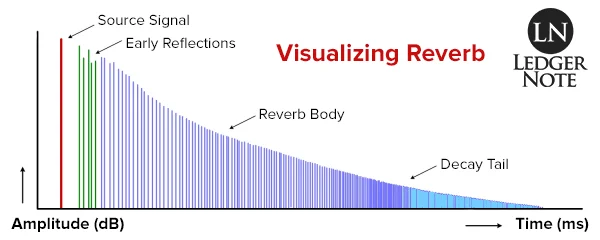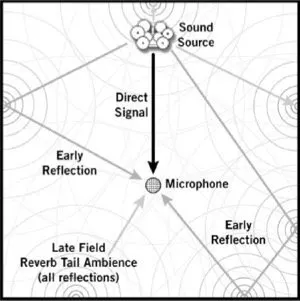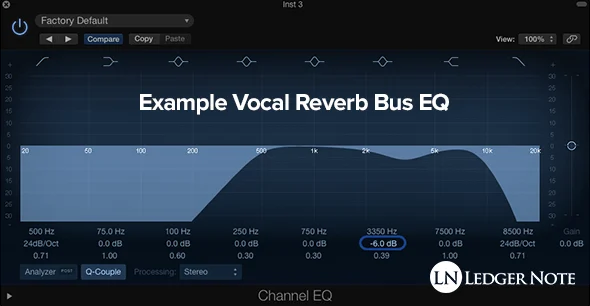
What is reverb? Is it different than an echo or delay? If so, what makes it different. Why is it used in music production? How is it created?
This is the logical sequence of questions that arise when you start considering this natural sound effect for the first time. What people don’t realize is that they know what reverb is, they just hadn’t attached a word to it before.
As a matter of fact, not only do we hear reverb constantly but most of us have probably never even heard a sound or piece of audio without some amount of it, unless we’re one of the very rare few who’ve ever been in an anechoic chamber. And when you do hear it, it’s actually extremely weird.
Let’s jump into this with a bit more of a technical explanation, explain how and why it’s used, and then discuss the different types of reverb and the acoustic environments they emulate. When we’re done you’ll have a full handle on this effect and how to use it.
What is Reverb?
The best way to understand this effect is to get a handle on how it’s created out in nature. Later we’ll talk about how we artificially recreate it to be used in audio production like music and movies.
Explaining Reverb Through Delay & Echo
Most people are familiar with the concepts of delay and echo. Delay can be thought of as a duplication of a segment of audio which is played again after a certain amount of time. Echo is the exact same thing but the audio is played over and over, spaced out by the same time period, getting quieter each time.
If you were standing over the edge of the Grand Canyon and screamed “hello” into it, after a few seconds you’d hear someone that sounds just like you say it back to you. The second “hello” is the echo and the amount of time that went by is the delay time.
Now imagine you’re standing at the bottom of the Grand Canyon with the tall walls going up in front and behind you. If you screamed “hello” into the front wall, the sound would bounce off that wall and into the back wall, then back to the front, over and over while getting quieter until it lost all of it’s energy.

That’s what reverb is. It’s an echo that repeats thousands of times and happens in such a quick manner that you no longer hear them as individual echoes. What you hear is a “smearing out” of the sound over time.

This happens all the time. When indoors, sounds bounce off of the walls, desks, bookcases, cabinets, etc. When outdoors sounds reflect off of building exteriors, the street, trees, road signs, and even the air. You can’t escape it in nature. Sound reflections are everywhere, just like light.
What is the Reverb Effect?
The reverb effect is simply the addition of reverb to a recording or live sound systems in order to make it either sound natural or to make it sound like it is emanating from a different type of room.
In studio recording we record audio tracks as ‘dry’ as possible, meaning with as little reverb or other unwanted effects added by the room. We do this through the use of acoustic treatment, which absorbs the energy of sounds to stop them from reflecting off of the walls.
In live performances, a bar venue or big auditorium may not exude the type of reverb demanded by the artistic intentions of a songwriter. In these cases, we add reverberation to provide a certain imaginative or emotional effect.
How We Recreate Reverb in the Recording Studio
There are three historical methods of recreating reverb. Only the second and third are used these days, with the bulk majority of applications being created using the third. They are:
- Mechanical
- Analog
- Digital
The challenge is we have to make a sound persist over time in the form of reflections, and each reflection has to decrease in amplitude until it becomes silent. And then we need to be able to control the frequencies which are emphasized, how quickly the amplitude decreases, reverberation time, and other factors so it becomes a useable effect.
It turns out, thanks to the studies of psychoacoustics, that if a sound’s subsequent reflections occur with at least 50 milliseconds between then we hear them as distinct echoes. So we have to reproduce these reflections incredibly fast, one after another. How is this done?
Mechanical Reverb
In the early days, we started creating reverb in natural echo chambers (a room that we liked the sound of). Eventually we even started building them to certain specifications, but this was expensive.
The famous music producer Phil Spector used this method to create his famous Wall of Sound style that was used on songs by The Beatles and The Beach Boys, for example. The band would either perform in the chamber or their completed songs would be played back through speakers in the room and re-recorded.
These chamber reverberators fell out of favor due to having to construct a different room if you wanted to change any of the parameters of the effect. It was expensive and required space in a studio to build. These still exist and are used in studies, but not in studio recording much.
Some bands will still seek out special rooms to record in. Led Zeppelin recorded “When the Levee Breaks” in a stone staircase. Yes has recorded in the sonic warmth of a wooden barn and even in a pub that Jon Anderson liked. These eclectic decisions are happening less frequently since the 1960’s, though.
Analog Reverb
Plate reverberators were the next breakthrough. A large, thin plate of sheet metal is made to vibrate using a transducer like is used to vibrate the cones of speakers. This creates sound which is then recorded using contact microphones.
The revolution here is that the reverb could be recorded separately from the original audio source and added in at different volumes or altered using signal processing. The flavors of reverb created could be changed based on the thickness and size of the plates and power in the transducers.
Perhaps the most famous early examples of plate reverb comes from Pink Floyd and The Beatles, who used this invention at length at Abbey Road Studios. Their unit, the Elektro-Mess-Technik EMT 140 weighed 600 pounds! The plate method is why Pink Floyd records always sounded so dark and eerie.
Spring reverberators are very similar to their plate cousins, except the transducer is attached to one end of a metal spring and a pickup at the other end to record the result. The patent for the first spring reverb tank was awarded to Laurens Hammond (of organ fame) in 1939, but they never spread much further than organs and guitar amplifiers.
They were cheap to create and much smaller is size than plates, but never caught on due to unwanted effects created by the movement of the spring itself (past the intended vibration). Guitarists will rock their amps to create thunderous sounds on purpose, but many couldn’t risk this happening by accident.
Digital Reverb
Emulation of any previous method plus new reverb creation methods became possible with the advent of computers. In signal processing (how we add effects to all audio signals) is done using algorithms that can mimic electronic circuits in serial and parallel and can mimic other analog systems.
These days, this is how the best reverb pedals work for guitar effects units. It’s how VST plug-ins work in your digital audio workstation. It’s how synthesizers can add the effect as well. It’s the current best method and will likely remain so forever. Pure emulation or convolution reverb (taking a sample of a reverb’s impulse response to model a space) are both done digitally.
The Different Types of Reverb
You probably realized that a tiny room will create a much different type of reverb than a spacious auditorium will. Though there are basically an infinite amount of ‘verbs’ you could configure, they all fall into a handful of main categories, plus a couple special categories.
The reverb types we have settled on (and their characteristics) are:
- Room – Basic, Warm, Short
- Hall – Even, Neutral, Long
- Chamber – Complex, Colorful, Medium
- Plate – Smooth, Bright, Variable
- Spring – Metallic, Dark, Variable
- Ambience – Ambiguous, Digital
In addition, there are two special applications, called dereverberation (removing reverb) and reverse reverb (having it swell up leading into the original sound, instead of trailing out after). If you want to learn more about these, please read our article: 7 Types of Reverb: The Different Flavors of Soundscape Design.
Using Reverb in Live Sound
Reverb is applied in live sound either at the mixing board, in a rack mounted processing unit off stage, or through an effects pedal controlled by the musician. The important consideration is the lack of the ability to spend much time on the fly cleaning up the isolated reverb (if you even have that at all).
Bearing that in mind, one should remember that the more reverb that is applied, the less their own instrument will “cut through the mix” becoming less intelligible and more muddy. Any attempt to fix this by increasing their volume will upset the mix and mask the intelligibility of other instruments in the mix.
Therefore, reverb volumes should be mixed in fairly low, with higher levels allowable the more sparse the instrumentation is or if one is taking a solo. If performing in a large cathedral hall there will be no need for additional reverb, and it may worsen the mix if added when a live audience is present that is allowed to wander about and carry conversation and dance.
Recording & Mixing with Reverb
Mixing with reverb provides plenty of time to deal with, and isolation of, the reverb bus in order to maximize its usage while maintaining clarity in the mix. What is particularly useful is to add an equalizer to the bus in order to scoop out the middle frequencies to reduce clashing in that range Adding a low roll-off also helps keep the bass region clear without muddying up the low mids.

Most studio engineers and mixing engineers will prefer if instruments are recorded completely dry, with the exception of a slight amount of compression. No reverb should be recorded at the input, because then the effect is “committed to tape” and can’t be altered or undone.

Through the use of equalization, addition of a pre-delay (gab between the original source audio and the beginning of the effect), mono or stereo choices, and the panning of the effect, a mix can have optimal clarity while still using lush amount of reverb to create an amazing soundscape.
So What is Reverb Then?
To recap in plain language, reverb is a series of echoes that happen in such quick succession that they can’t be heard as individual sound events. They become one sound that resembles a “smearing out” of the original sound. It happens in nature constantly, and rarely does it ever not occur.
Thanks to our genius sound engineers and computer scientists, we can now apply this effect at will, changing every aspect of it to suit our whims. We use it to make recorded sounds seem natural, mimic another acoustic environment, or to create an emotional response. We’ve not only answered what is reverb but also how we create it and use it.